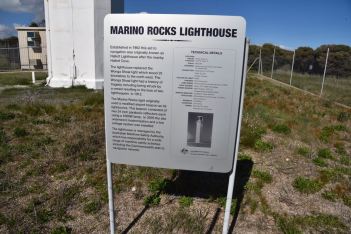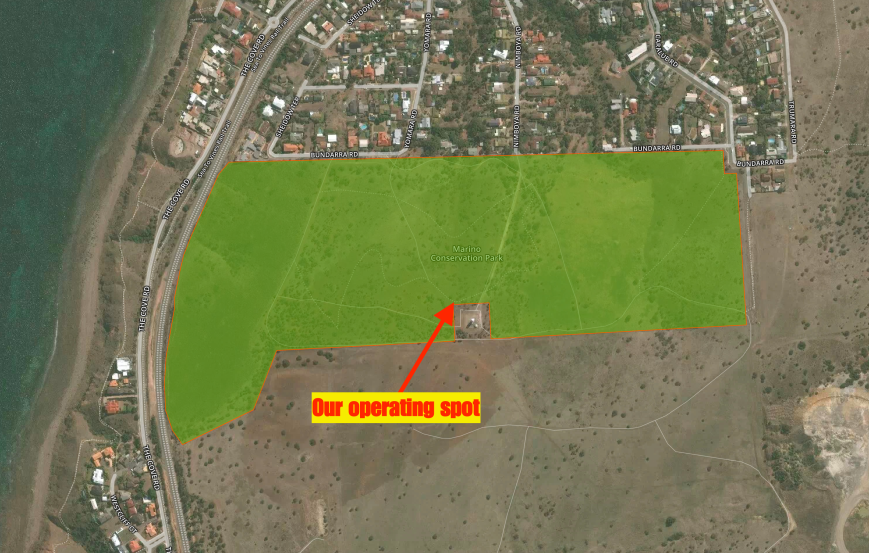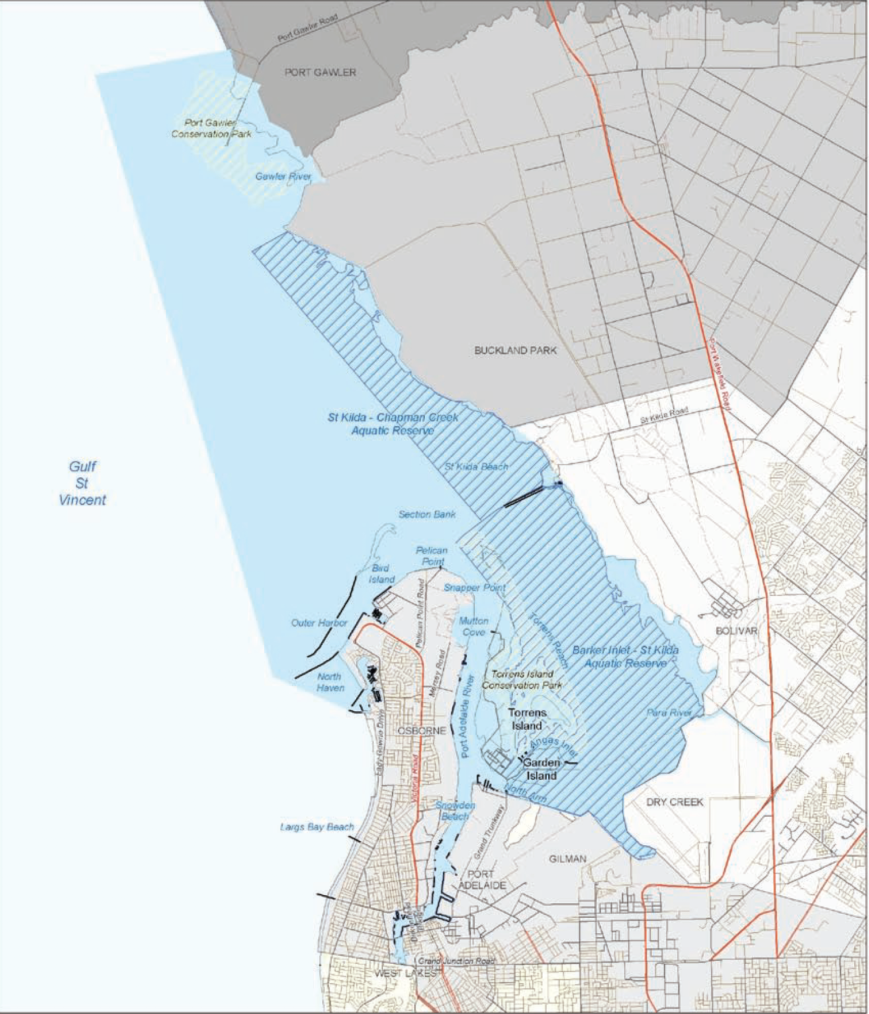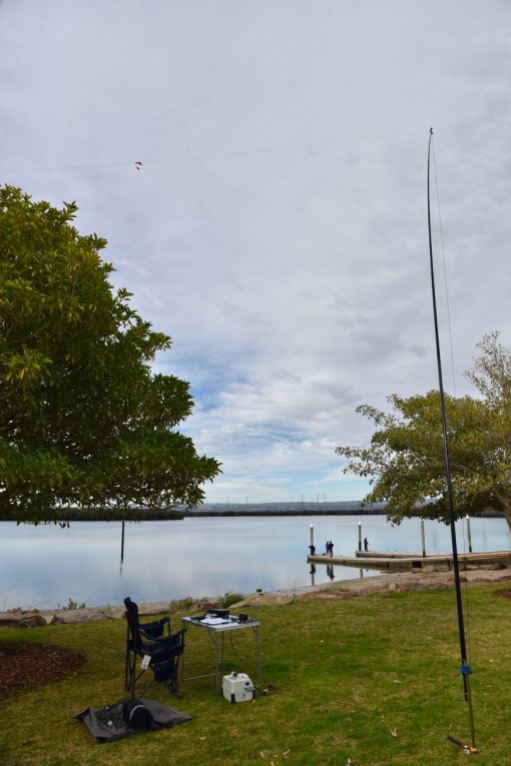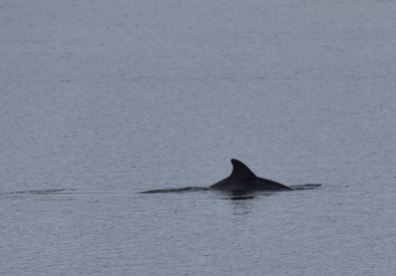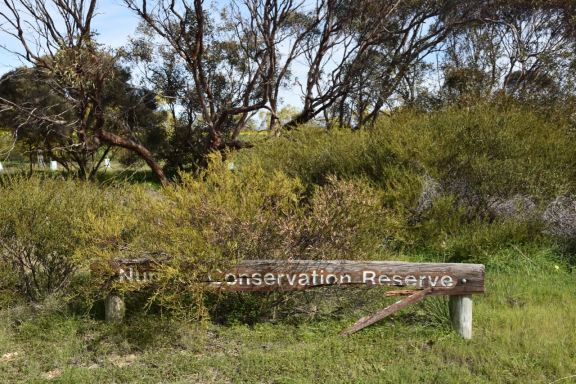I have just finished 7 days straight at work and I was very keen to head out to activate a park today (Monday 28th August 2017). I am running out of parks within about 300 km from home, but one park I have not activated is the Lawari Conservation Park 5CP-278 & VKFF-1767. The park is located about 100 km south of Adelaide and about 56 km south of my home in the Adelaide Hills.

Above:- Map showing the location of the Lawari Conservation Park south of Adelaide. Map courtesy of Location SA Map Viewer.
Lawari Conservation Park is located on Hindmarsh Island and is accessed via the township of Goolwa, which is a historic river port on the Murray River near the Murray Mouth. In the local Ngarrindjeri aboriginal language, Goolwa means ‘elbow’. The area was known as ‘The Elbow” by many of the early settlers. Before 1837 the area was briefly considered for the site of the capital of the colony of South Australia. Goolwa was Australia’s first inland port (1853) built to connect Goolwa to Port Elliot and later extended to Victor Harbor, allowing goods to move from river boats to sea boats, so that neither had to negotiate the Murray Mouth.

Above:- Aerial view showing Goolwa, the Hindmarsh Island bridge and the island, and also the Coorong. Image courtesy of Alexandinra Council.
Hindmarsh Island, known Kumerangk in the local aboriginal language, is a popular tourist destination. Tourism to the island has increased in popularity since the opening of the Hindmarsh Island bridge in 2001.

The island is 45.5 km2 in size, with a length of 14.7 km and a width of 6.5 km. The island has a coastline of 43.7 km. Its highest elevation is just 25 metres. The island’s population is around 1,200. It has a marina development and tavern.
Construction on the Hindmarsh Island bridge, linking the island to Goolwa, commenced in October 1999, with the bridge being completed in March 2001. The bridge is 319 metres in length, with a height of 19 metres.
The bridge became a focus of national controversy when a group of local Indigenous people, the Ngarrindjeri, and some landowners objected to its construction. It was alleged that the Ngarrindjeri objectors fabricated the cultural significance of the island (the Secret Women’s Business) in order to help fight the development. A later Royal Commission decided that the Secret Women’s Business was in fact made up. Construction was blocked by the Keating Labor Government, but given the go-ahead by the Howard Liberal Government in 1996.
Five years after the Royal Commission findings, the Ngarrindjeri who had stated the bridge desecrated sites sacred to women were vindicated, with a Federal Court Judge finding that restricted women’s knowledge was not fabricated or that it was not part of genuine Aboriginal tradition.

Above:- the Hindmarsh Island bridge. Courtesy of Alexandrina Council.
The first European to set foot on Hindmarsh Island was Captain Charles Sturt. He used the island as a viewing point and from there he sighted the Murray Mouth. Captain Collet Barker surveyed the Murray Mouth but was killed by aboriginals after swimming across the Mouth. The island was named by Captain John William Dundas Blenkinsop after South Australia’s first Governor, Sir John Hindmarsh.
Above:- Captain Charles Sturt (left) and Sir John Hindmarsh (right). Images courtesy of wikipedia.
There is a monument on the island which commemorates explorers Captain Charles Sturt and Captain Collet Barker near the site where Sturt first saw the waters of Encounter Bay.
Dr. John Rankine (1801-1864) was granted an occupational licence to become the island’s first grazier. He is recognised as founding the township of Strathalbyn, just down the road from my home.

Dr. John Rankine. Image courtesy of wikipedia
The Lawari Conservation Park is a relatively new park, having been gazetted on 21st March 2017. The park is 1.058 km2 (1,058-hectare) in size and is located at the eastern end of Hindmarsh Island, within an area of wetlands that support a large number of threatened fish and water bird species. The park supports three native fauna species of national conservation significance, and a further 30 fauna and one flora species at the state level, including the Far Eastern Curlew and Cape Barren Goose. It is situated within an area of internationally important wetlands formally recognised as the Coorong and Lakes Alexandrina and Albert Ramsar Reserve.
Lawari Conservation Park comprises two former grazing properties, purchased with assistance from the Commonwealth’s National Reserve System Program for inclusion into the protected area system. This includes the former Wyndgate property.
The park includes approximately 400 hectares of fenced paddocks where cropping and cattle grazing continue under a lease agreement. These farmed paddocks are managed in a way that provides a high quality summer feeding habitat for Cape Barren geese. Although I did not sight either of these 2 birds, the park was alive with various other native birds. See my photos below.
Despite this being a large park, there really are limited operating opportunities. To start off with I travelled along Denver Road towards the old Wyndgate homestead. I reached a gate, which was open, and ventured a few hundred metres down the road, but found some cars parked at the homestead, so I decided to turn around as I was not sure if I was allowed to be where I was.

Above:- the gate at Denver Road
I then travelled back along Denver Road and then onto Randell Road. I soon had the park to my right. However, there was an electric fence and no tree cover.
I travelled to the very end of Denver Road, but could not find any suitable places to access the park. There were some nice views from here across the water to the little town of Clayton.

There was even a trig point here, but no SOTA summit!

I then travelled to the end of Mills Road, but again did not find any suitable access points into the park. I then tried Goolwa Channel Drive, but with the nearby shacks and holidays homes I decided against this spot due to the possible noise.
I decided to try my luck along Mundoo Channel Drive. Along the way I detoured to the Murray Mouth lookout.
The Murray Mouth is influenced by the flow of River Murray water through the barrages and tidal movement from the Southern Ocean. When River Murray flows to South Australia are low, barrage releases are low and sand deposits occur inside the mouth causing restrictions and increasing the risk of closure. It is important that the mouth remains open to maintain connectivity between the river, the Coorong and the Southern Ocean, to discharge salt and other nutrients out to sea, and to maintain healthy ecosystems in the Coorong.

This is certainly well worth a look if you are on the island. There are also some great views of the Coorong, a lagoon ecosystem which runs parallel with the coastal dunes for about 140 km. Its name is thought to be a corruption of the local Aboriginal people’s word kurangh, meaning “long neck”; a reference to the shape of the lagoon system. The name is also thought to be from the Aboriginal word Coorang, “sand dune”, a reference to the sand dunes that form the Younghusband Peninsula.
A huge amount of planting of native plants is being undertaken in the park. During my visit there were a number of planting teams hard at work in the park.
I set up off Mundoo Channel Drive. There was a newly created car parking area opposite the boat launching area. I climbed over the fence and found some shade and set up my deck chair and the fold up table. I ran the Yaesu FT-857d and the 20/40/80m linked dipole for this activation, with the power output set at 40 watts.

Above:- Map showing the park boundaries (in green) and my operating spot. Map courtesy of Location SA Map Viewer.
My operating spot was opposite Mundoo Channel and in close proximity to the Coorong National Park and the Mouth of the Murray, as the photo below shows.

Above:- The Mouth of the Murray. My operating spot on Hindmarsh Island is indicated with the red arrow.

Above:- Aerial view of Hindmarsh Island, showing my operating spot, my home QTH, the Murray Mouth, and Adelaide in the background. Image courtesy of Google Maps.
I headed to my nominated operating frequency of 7.144 and started calling CQ. First in the log was Geoff VK3SQ who was become a regular park hunter. Geoff had a very nice 5/9 signal from Beechworth in north eastern Victoria. This was followed by Malcom VK1AAH in Canberra, who was also 5/9, followed by Rod VK7FRJG in Tasmania (also 5/9), and then Stuart VK3STU in Melbourne (again 5/9). Band conditions on 40m seemed very good.
As it was a Monday, calls from the park hunters were not as frenetic as a weekend. It took me about 20 minutes to reach contact number 10, qualifying the park for me for the VKFF program. Contact number 10 being with Mike VK3KMH who was 5/9 +. Callers were steady but it appeared as though I may not get the 44 QSOs required to qualify the park for the global WWFF program. I had to resort to John VK4TJ giving me his other calls from Canada and the USA, to make up the numbers.
It wasn’t until about one hour into the activation that the callers started to really pick up. I run a paper log out in the field, and each page contains 34 QSOs. I always enjoy reaching the 34 QSO mark, as this means a new page, and just 10 QSOs to go for the park to be qualified.
I ended up logging a total of 53 QSOs on 40m from VK1, VK2, VK3, VK4, VK5, and VK7, with the vast majority of signals being very good. Even the lower down stations were very readable, as there was NO noise in the park. The band was dead silent when I released the PTT button. Close in propagation was not working on 40m, with only Les VK5KLV from Port Augusta and Greg VK5GJ logged.
I headed off to 80m where I called CQ, and this was answered by George VK3MVP who had followed me down from 40m. Next up was Greg VK5GJ running QRP 4 watts with a good 5/8 signal. I logged a further 8 stations on 80m from VK2, VK3, and VK5. Again, despite it being daylight, my signal was being quite well heard in Victoria and New South Wales. I would encourage all park activators to give 80m a go during their activation.
I then headed over to 14.310 on the 20m band and logged just 3 stations. The first being John VK4TJ, followed by Jonathan VK7JON, and finally Phil VK6ADF.
To complete the activation I head back to 40m for a quick QSO with my wife Marija VK5FMAZ, who had arrived home from work.
After 2 & 1/2 hours in the park I had a total of 67 stations in the log, on 20, 40, & 80m SSB, and another unique park in the bag for me as an activator.
I worked the following stations on 40m SSB:-
- VK3SQ
- VK1AAH
- VK7FRJG
- VK3STU
- VK2GKA
- VK2FABE
- VK3BBB
- VK3PF
- VK2NP
- VK3KMH
- VK7JON
- VK2VRC
- VK3TKK/m
- VK3ZMD
- VK3ARG
- VK4RF
- VK4HA
- VK3PAT/m
- VK3OHM
- VK3FLJD
- VK3MBW
- VK4TJ
- VK4/AC8WN
- VK4/VE6XT
- VK1JY
- VK1AT
- VK3FMAA/m
- VK3KMA
- VK3VGB
- VK2DSG
- VK3FJAE
- VK3UH
- VK2HHA
- VK3GGG
- VK3PMG
- VK5MR
- VK3DHI/4
- VK3FAHS
- VK1FWBK
- VK2YMU
- VK5KLV
- VK3MVP
- VK3FOTO/m
- VK5GJ
- VK4VCO/m
- VK4YLU
- VK3VIN
- VK3GAZ
- VK3UT
- VK4HNS
- VK3PTL
- VK2LO
- VK2SOL
- VK5FMAZ
I worked the following stations on 80m SSB:-
- VK3MVP
- VK5GJ
- VK5ATN
- VK5FANA
- VK5PL
- VK5KLV
- VK3PF
- VK2EXA
- VK3SQ
- VK2MOP
I worked the following stations on 20m SSB:-
- VK4TJ
- VK7JON
- VK6ADF
References.
Department of Enviroment, Water and Natural Resources, 2017, <https://www.environment.sa.gov.au/Home/Full_newsevents_listing/News_Events_Listing/170419-new-park-lawari>, viewed 28th August 2017
Natural Resources SA Murray Darling Basin, 2017, <http://www.naturalresources.sa.gov.au/samurraydarlingbasin/projects/all-projects-map/wyndgate-property-planning>, viewed 28th August 2017
Wikipedia, 2016, <https://en.wikipedia.org/wiki/Goolwa,_South_Australia>, viewed 28th August 2017
Wikipedia, 2017, <https://en.wikipedia.org/wiki/Hindmarsh_Island>, viewed 28th August 2017
Wikipedia, 2017, <https://en.wikipedia.org/wiki/Lawari_Conservation_Park>, viewed 28th August 2017
Wikipedia, 2017, <https://en.wikipedia.org/wiki/Coorong_National_Park>, viewed 28th August 2017































